Shot 7
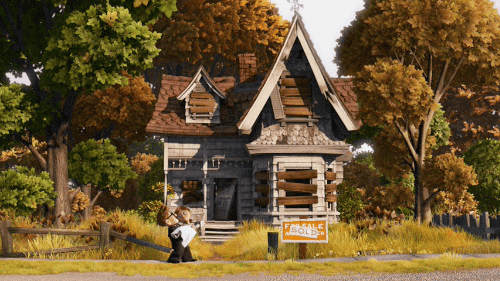
There’s a lot of narrative information being thrown your way in this shot. It’s the house they met in as kids with a sold sign in front, so we have the beginning of the realization of a childhood dream.
The house is boarded up, but they’re headed straight to it from the ceremony. They’re still in their wedding clothes, and Carl is not just carrying Ellie over the threshold, he’s been carrying her down the block. They’re showing us how eager they are to get their life together started.
This is the first exterior shot of the montage. It’s autumn, and there are plenty of trees behind us to make that point. It’s also important to consider where we’ll end the montage, with this wooded area having been knocked down by construction crews. What looks like a large, wooded suburban lot will give way to urban development.
But we’re not there yet. Even so, this clashing of autumnal decay and a house in need of repairs with their excitement and the connection to their childhood dreams complicates the image. It’s simultaneously hopeful and elegaic.
This is also the moment that introduces the musical theme for the montage. As it plays out, it will cycle and vary itself in mood along with the visuals. There’s more to say about that, but for the moment, it’s establishing a baseline motif over the next few shots.
Shot 8
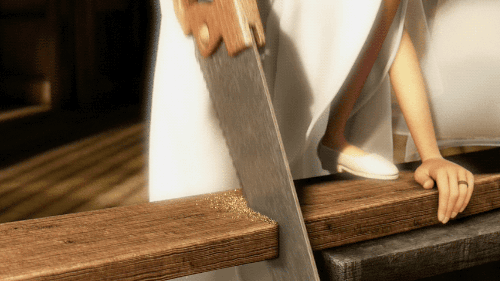
We move from our first wide, external shot to a dramatic close up.
It’s a technique that uses the cut to transition quickly from the general to the specific. It asks and answers a question. “Aren’t they going to need to do a lot of work to live in this house?” “You betcha. Here’s an example of that work.”
The frame is filled with an image of Ellie sawing a board. The composition places lots of diagonals in the frame, and this dynamism is accentuated by the motion of Ellie’s sawing.
Even though it’s a close up, we can still tell she’s wearing her wedding dress. More on this with the next shot.
The focal points of this shot are the aggressive work she’s doing sawing that board, and how the hand holding the board in place has her wedding ring prominently displayed to the viewer.
Hands are a big part of the imagery of this montage, and we’re already getting a taste of it.
Shot 9
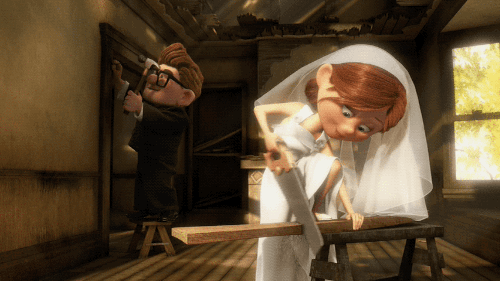
The cut moves us back from the previous shot to continue the action of Ellie cutting the board, but now we see that both of them got in the door and didn’t even bother to change clothes before they started getting to work.
This is plucky. As an audience, we like plucky.
We like characters that don’t just have goals, but do the work to get there. It feeds into that part of the brain that likes to see the impossible whittled down to the achievable. We want to believe that the big tasks in our life can be made small, and that when we have purpose and drive, we can accomplish great things.
There’s a vicarious rush seeing that drive in characters on screen, especially when they endear themselves to us and we connect to their hopes and fears.
Yes, it’s unrealistic that they wouldn’t change clothes, but it fits with the elastic reality the movie is establishing (more on that later), creates a humorous moment, and uses a broad stroke of the narrative brush to quickly convey how desperately these two want to get this house fixed up.
Shot 10
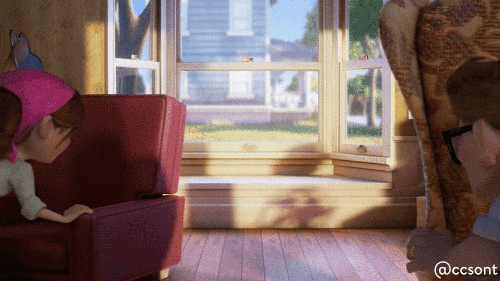
We’re jumping ahead to seeing them move in. It’s a great narrative leap, moving from the first boards and nails they put in to the finishing touches.
As we’ll learn later, they’re moving each other’s chairs into place. Teamwork, but also the sense that each is helping to complete the other.
The chairs have a similar shape and style to the characters that will sit in them. Carl’s is square, short, and plain. Ellie’s is tall and covered with a striking pattern. She is dynamic, and so is her chair.
Also, look at the placement of the chairs in the room. The backs are to the window. Great for getting light for reading, but it’s also an expression of the inward, exclusive nature of their relationship. They are each enough for the other, and the rest of the world need not apply. It’s charming, understandable, and setting up the pain that Carl will feel later with Ellie’s passing.
By using the window as a backdrop, we’re also getting a hint at how long the process took. We were in Autumn when they started moving in, and now we see signs of Spring.
Shot 11
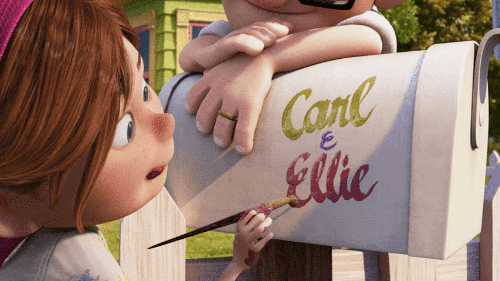
Start with the obvious. It’s a mailbox. What’s missing?
An address. Instead, we see “Carl & Ellie.”
An address is useful for the outside world wanting to contact the people who live there. Writing their names on the mailbox creates a sense of ownership, but also signals the preference for each other’s company over that of the outside world. Think about the chairs from the previous shot.
Then there’s the prominent placement of Carl’s hand. Again, hands are playing a large role in the way the story is told.
Carl rests his hand on the mailbox, displaying his wedding ring to the audience. When he lifts his hand, we get the “Oops” moment of Carl thinking he’s ruined the work that Ellie has done by smearing paint on it.
Ellie shrugs it off and adds her own hand print, turning what could have been a mistake into something purposeful. Taking the unexpected in stride. This is a defining moment for their relationship and our understanding of it. They balance each other and help each other to accept the unexpected.
Look at the way their handprints overlap. Like they’re holding hands. It’s clear imagery directed at the target audience. This movie needs to communicate to everyone from 5 to 95 what’s going on, and holding hands is one of the most basic signs of affection you can use that will be understood across that spectrum.
Shot 12
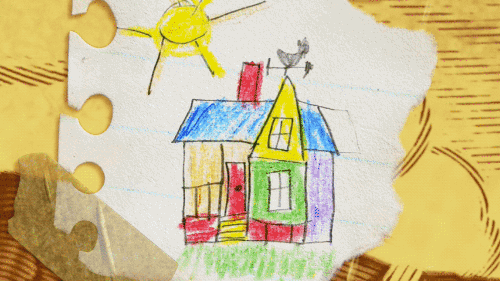
We cut to a page from Ellie’s Adventure Book. It’s her childhood drawing of the house, and how she wanted it to look.
The image falls away, putting us into the point of view of Ellie and/or Carl as they compare her original vision to the finished product. This positioning further cements our emotional connection to the hopes and fears of these characters. We are, for a moment, literally in their place.
Everything is centrally framed in the shot, and the falling of the paper creates a dynamic sense of energy to the static composition. We are seeing the realization of a childhood dream, and this positive energy lifts the audience’s spirits along with the characters. Hard work has paid off.
Also of note, we’re in Spring now based on the trees surrounding the house. It not only tells us how much time has passed but keeps us paying attention to the use of seasons as a narrative tool. We should be thinking about the passage of time, not only from childhood to adulthood, but about the continual progression into the future.
You must be logged in to post a comment.